Bedwyr Williams is gazing out of the window when we speak on the phone, out through his Caernarfonshire garden towards the south-west tip of Anglesey. "I can do one thing or the other," says the artist, who represented Wales at this year's Venice Biennale. "I can negotiate having a social life living in a city, or I can be an artist. I found I can't do both … Britain has become so complex to be poor in. At least if I am skint here, I can look at the mountains."
In the 1990s and on into the early years of this century, it was a given that most of the artistic expression in Britain – or, at least, the type of artistic expression that was fashionable, institutionally recognised and socially concerned – was likely to have its roots in urban life. The city – its architecture, its rough-hewn textures, its harsh yet exhilarating stories of people divided by race and class – was the stuff of plays, art and pop. The inner city, shaking off the urban blight of the 1980s, was cool, nowhere more so than Shoreditch in east London, which became the de facto centre of the UK art world.
But there is a change in the weather. It is no longer embarrassing, boring or old hat to make work in, or about, the countryside. There has been a drift of big art stars out their old London stamping grounds: Sarah Lucas is in Suffolk, Damien Hirst has a pile in Gloucestershire. Perhaps, though, the most obvious sign of Britain's renewed love affair with the rural is the rise of "the new nature writing" – which, in the words of its great exponent Robert Macfarlane, is "distinguished by its mix of memoir and lyricism, and specialises in delicacy of thought and precision of observation". As recently as 2003, when Macfarlane won the Guardian first book award for Mountains of the Mind, he bemoaned "the withering away of British nature writing". Now, with writers such as Olivia Laing, William Fiennes and Richard Mabey, it is flourishing.
Take, too, the re-emergence of folk music, in the 1990s the embarrassing, socks-and-sandals uncle of British pop. At its most commercial, this revival has spawned such bands as Mumford & Sons. But at the other end of a wide spectrum there is a real avant garde at work in the English countryside. Banish thoughts of hey-nonny-nonny when it comes to Hacker Farm, a Somerset-based electronics collective who make amps out of milk churns and brew their own cider. Reviewing their album UHF, the Guardian's Alexis Petridis wrote: "It paints a picture of country life quite unlike anything else in current music: harsh, mechanised and poverty-stricken, forgotten in an era that tends to concentrate on urban deprivation … the rhythm tracks clank and whirr like rusting machinery."
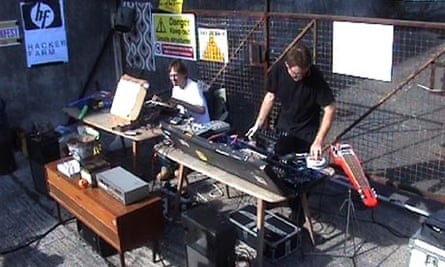
At its most interesting, the new artistic thinking about the countryside is far from nostalgically pastoral; rather, it acknowledges poverty, brokenness, unemployment, the full dystopic gamut. Hacker Farm say they make "broken music for a broken Britain". And Jez Butterworth's hit 2010 play Jerusalem (the author lives in rural Somerset) felt so fresh because it looked at the countryside not as a bucolic idyll, but as messed-up, druggy and edgily dangerous.
Director Elizabeth Freestone runs her theatre company, Pentabus, from "a farm in the middle of nowhere in Shropshire" with dodgy phone reception, slower-than-average broadband, higher-than-average fuel prices and unusual demands made on actors (such as digging themselves out of snowdrifts in order to reach icebound venues in winter). Jerusalem, she says, was "an absolute lodestar" for new theatre writing about the countryside. "One of the things it did was talk about the rural working class, who had been essentially invisible in contemporary culture. People are realising that there are extraordinary stories to be found in the country." Urbanism, she adds, "is a bit of a cultural dead end. It's become a bit predictable as material."
Authors come to Pentabus on residencies and work in the "writers' shed – a former pigsty" (the kind of cheap, ex-industrial or quasi-industrial buildings that artists love to colonise are becoming easier to find in the country than in gentrified cities). The company tours work to village halls and small rural venues. "People used to think that rural audiences were unsophisticated and you couldn't do plays with swearing in them," she says. "In fact, our audiences are as hungry for contemporary playwriting as anyone."
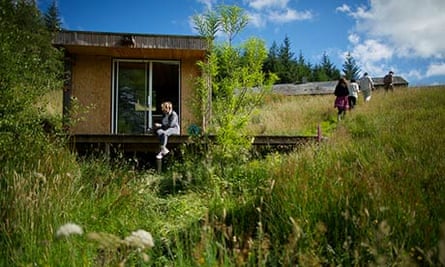
An unpatronising attitude to the locale is also what distinguishes Grizedale Arts, an organisation based in a medieval charcoal burners' cottage high above Coniston Water in the Lake District. It is Grizedale that co-commissioned Laure Prouvost to make her Turner-nominated film installation about Kurt Schwitters, the artist who made his home in the Lakes after he was denounced by the Nazis. When I visited, Prouvost was back again, shaping clay pots for the enlarged version of the work she will show in the Turner prize exhibition this autumn. Adam Sutherland, Grizedale's director, looks to 19th-century Coniston residents John Ruskin and his friend and biographer WG Collingwood as his guides: they used their artistic knowledge to introduce craft skills such as lacemaking and woodcarving to the village to help its economy.
When artists come on residencies to Grizedale, they are invited to make something useful for the community. Liam Gillick, for example, designed a reading room for the Coniston Institute. Giles Round is in residence, too. He is designing some furniture for a restaurant that will be run by the village youth club at an art biennale.
Also in the Coniston Institute is the Honest Shop, an emporium founded by Grizedale that sells village-made crafts and produce. One Coniston resident has taken herself and her family backpacking round Italy off the proceeds of Honest Shop cake. When Grizedale was resident at Frieze art fair in London last year, the youth group made £400 selling fruit juice to art collectors; knitted fruit and veg made by a Coniston woman was sold for £15 a piece. (That's London prices. You can find it for £2 in the Honest Shop – I came away with a lovely knitted pear.) Sutherland's approach declines to see "professional" artmaking as a separate category from the everyday creative acts of the local knitters and bakers; the Honest Shop is, for him, a form of public art.
This is a radical departure from the recent commodification of the urban art scene (though it bears a resemblance to the kind of work Jeremy Deller and fellow artist Alan Kane have done to document contemporary folk art). It is an approach that is also bracingly pragmatic, prepared to insert itself into hip urban contexts such as Frieze if there's a bob or two to be made. "We're not interested in 'making art'", says Sutherland. "We're trying to evolve ways of artists working in society that's enriching to the community." As Sutherland shows me his kitchen garden carved out of the inhospitable hills, I admire the view, but Sutherland, who was himself brought up on a farm, won't indulge any hint of rural romanticism. "This is a workplace," he says. "I never go for a walk." I'm reminded of the late artist Ian Hamilton Finlay's remark: "Certain gardens are described as retreats, when they are really attacks."
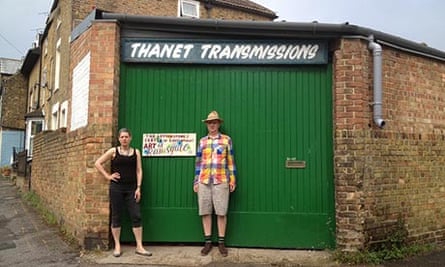
On a basic level, artists need cheap space (visual artists more than most), and they are being priced out of London. One drizzly summer day I visit the artist known as Bob and Roberta Smith at his studio in Ramsgate: he is part of a drift of artists and other creatives from east London to the Kent coast (though Smith keeps a foothold in London). Doubtless, as they were in Shoreditch, he and his ilk are the shock troops of gentrification. His studio is a roomy converted garage piled with artworks, crates, old LPs, an ancient wireless set and a tarnished trumpet. I'd thought of him as a very London artist, but during our conversation he places his work, with its paintings resembling homemade sign boards, in the world of the cheery, tawdry visual language of the English seaside. (His father, landscape painter Frederick Brill, brought the family to Swanage on holiday every year while he painted the Dorset coastline.)
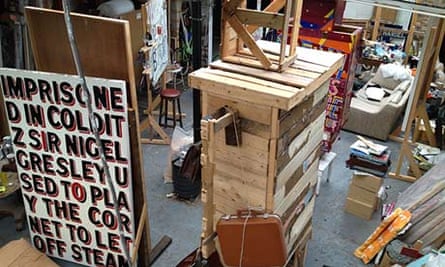
Another day, I head out east from London to Thorpe-le-Soken, an Essex village near where Rob Tufnell and his partner, Michelle Cotton, live. Cotton is senior curator at Firstsite, the contemporary art gallery in Colchester; Tufnell is director of the Sunday art fair, which takes place in London in October. Their departure from the city has a symbolic ring to it. The day the Olympics started, they received a letter telling them their rent (for a tiny Bethnal Green flat) was going up by 30%. Also a little disillusioned by the "generic" gentrification of east London, they decided to look for somewhere to live in the country near Cotton's workplace and found, rather miraculously, a heartstoppingly pretty pink-painted cottage that was once home to the artist Eduardo Paolozzi (he moved to Thorpe in 1955). It is the full idyll: there are owls and woodpeckers in the garden ("and there are two tortoises that come with the cottage," says Tufnell); over the lane is a salt creek that Cotton swims in daily. Tufnell walks the three miles from the railway station – his thinking time, he says.
Paolozzi and fellow artist Nigel Henderson used to run a studio from here that made and sold ties, coffee tables, wallpaper and other domestic objects. They also came here from Bethnal Green. It's a reminder that there has always been creative traffic (and tension) between the city and country in British cultural life. Tufnell tells me a story about an art collector asking him what British art was like. He answered that it was "brown and green and grey". Maybe recently it has been a little more brash and shiny – but perhaps, when all is said and done, these are its default colours: brown, green and grey; mud, grass and sky.
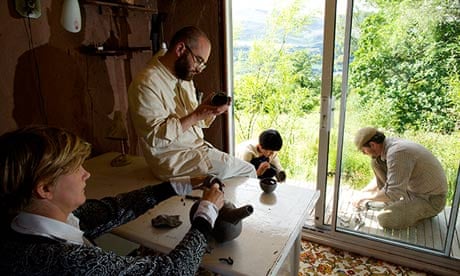
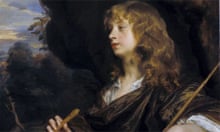
Comments (…)
Sign in or create your Guardian account to join the discussion